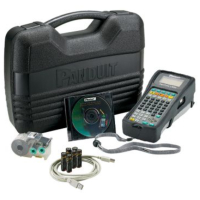Thermal Transfer Printing
Thermal transfer printed labels are easily identified by the crisp, often glossy, printed surface. The clarity is achieved by using a thin ribbon roll that when heated by the printhead melts onto the label to form the image. The ink is absorbed so that the image becomes part of the media. When matched with suitable media, thermal transfer technology is not only impervious to heat and moisture, but the image cannot be rubbed off, making the printed labels the most durable available. An additional benefit of this technology is the continuity of the printed image. Because the colour and density of the printed image is determined by the ribbon and the resolution of the printer, thermal transfer printing produces consistent, reliable printing on every label. This technique provides image quality and durability that is unmatched by other on-demand printing technologies.
The specific label material and ribbon must be carefully selected to ensure print performance and durability. By selecting the right media-ribbon combination, as well as specialty adhesives, users can create archival-quality labels to withstand temperature extremes, ultraviolet exposure, chemicals, sterilization, and more. Typical thermal transfer applications include: product identification; circuit board tracking; permanent identification; sample and file tracking; asset tagging; inventory identification; certification labels such as UL/CSA; laboratory specimens; cold storage and freezers; and outdoor applications.
Thermal Transfer Printing Advantages
- Thermal transfer delivers crisp, high-definition text, graphic and barcode print quality for maximum readability and scan ability.
- Thermal transfer printing produces long-life image stability.
- Thermal transfer enables batch or single label printing with virtually no waste.
- Long-term maintenance costs are low compared to dot matrix, ink jet and laser printing.
- Thermal transfer technology can print on a nearly unlimited variety of media stock (except multi-form).
- Thermal transfer printers are typically built more durably than dot matrix or laser printers, allowing reliable operation in industrial as well as office applications.
Thermal Transfer Printing Limitations
- Since thermal transfer printers require ribbon, supply costs are higher than direct thermal; however, thermal transfer printheads last longer than direct thermal printheads.
- Single-pass thermal transfer ribbon can be wasteful if little is printed on it.
- Thermal transfer ribbon is a poor candidate for recycling.
- To obtain optimum print quality in thermal transfer printing, the ribbon and media substrate MUST be compatible. Otherwise, the heat from the printhead could melt the ribbon onto the label causing internal printer problems.
|
What am I printing?
|
Thermal Transfer
|
|
Asset Labels
|
X |
|
Product Labels
|
X |
|
Shelf/Location Tags
|
X |
|
Wristbands (outdoor)
|
X |
|
Waterproof labels
|
X |
|
High temperature labels
|
X |

